-

新人教版高中英语选修2Unit 4 Reading and thinking教学设计
【词汇精讲】highlight n.最好或最精彩的部分 vt.突出;强调;使醒目One of the highlights of the trip was seeing the Taj Mahal.这次旅行的亮点之一是参观泰姬陵。Your resume should highlight your skills and achievements.你的简历应该突出你的技能和成就。The report highlights the major problems facing society today.报告强调了当今社会所面临的主要问题。I’ve highlighted the important passages in yellow.我用黄色标出了重要段落。7.Edmonton is freezing cold in winter,with daily temperatures averaging -10 ℃.埃德蒙顿冬季寒冷,日平均气温为-10°C。【词汇精讲】freezing adj.极冷的;冰冻的Leave a basin of water outside in freezing weather.在冰冻的天气里,放一盆水在室外。It’s freezing cold outside so wear a warm coat.外面超冷的,所以穿一个暖和一点的外套吧。8.It was not until 9:30 a.m.that they finally reached the capital of Ontario,Toronto.直到上午9时30分,他们才终于到达多伦多的首府安大略省。【句式剖析】本句是一个强调句,强调的是句子的时间状语until 9:30。含有not...until...的句子的强调句为It is not until...that...,that后面的句子要用肯定形式。It was not until then that I suddenly realized nobody was happier than I was.直到那时我才突然意识到没有人比我更幸福了。

新人教版高中英语选修2Unit 5 Reading for writing教学设计
你校英语报计划出版一期急救常识专刊,现面向全校学生公开征集稿件,你有意参加。请你根据下面提示内容,用英语写一篇短文,介绍在车祸现场对伤者进行急救的方法和步骤。1.确保现场的安全;2.询问伤者,确保其呼吸正常;3.检查伤口,如流血则应采取止血措施;4.如需急救,确保其处于康复位置。注意:1.词数80左右;2.可以适当增加细节,以使行文连贯。参考词汇:康复位置 recovery positionAs we all know, having a knowledge of first aid can make a great difference in our daily life. If a traffic accident happens and someone is injured, the following steps can be used to treat the injured.In the first place, we should make sure that the accident scene is safe so that we won’t get hurt. We should ask the injured person if he is OK, and see if he is breathing. What’s more, we should check for cuts and wounds. If he is bleeding badly, it is vital that we should try to stop the bleeding by applying pressure to the injury. This is because if a person loses too much blood, he may die. If necessary, take the injured person to the hospital as soon as possible.Do remember: when giving first aid, please be sure to place the person in a recovery position.

新人教版高中英语选修2Unit 3 Reading for writing教学设计
The theme of this part is to write an article about healthy diet. Through reading and writing activities, students can accumulate knowledge about healthy diet, deepen their understanding of the theme of healthy diet, and reflect on their own eating habits. This text describes the basic principles of healthy diet. The author uses data analysis, definition, comparison, examples and other methods. It also provides a demonstration of the use of conjunctions, which provides important information reference for students to complete the next collaborative task, writing skills, vivid language materials and expressions.1. Teach Ss to learn and skillfully use the new words learned from the text.2. Develop students’ ability to understand, extract and summarize information.3. Guide students to understand the theme of healthy diet and reflect on their own eating habits.4. To guide students to analyze and understand the reading discourse from the aspects of theme content, writing structure, language expression, etc., 5. Enable Ss to write in combination with relevant topics and opinions, and to talk about their eating habits.1. Guide students to analyze and understand the reading discourse from the aspects of theme content, writing structure, language expression, etc.2. Enable them to write in combination with relevant topics and opinions, and to talk about their eating habits.3. Guide the students to use the cohesive words correctly, strengthen the textual cohesion, and make the expression fluent and the thinking clear.Step1: Warming upbrainstorm some healthy eating habits.1.Eat slowly.2.Don’t eat too much fat or sugar.3.Eat healthy food.4.Have a balanced diet.Step2: Read the passage and then sum up the main idea of each paragraph.

新人教版高中英语选修2Unit 4 Learning about Language教学设计
This section guides students to pay attention to the typical context of vocabulary use, helps students accumulate vocabulary around the key vocabulary of this unit, and uses the learned words and word chunks in different contexts to deeply understand their meaning and usage, so as to achieve the purpose of review and consolidation.The teaching design activities aim to guide students to pay attention to the typical context in which the target vocabulary is used, as well as the common vocabulary used in collocation, so that students can complete the sentence with correct words. In terms of vocabulary learning strategies, this unit focuses on cultivating students' ability to pay attention to collocation of words and to use word blocks to express meaning.For vocabulary learning, it is not enough just to know the meaning of a single word, but the most important thing is to master the common collocations of words, namely word blocks.Teachers should timely guide students to summarize common vocabulary collocation, such as verb and noun collocation, verb and preposition collocation, preposition and noun collocation, and so on.1. Guide students to understand and consolidate the meaning and usage of the vocabulary in the context, 2. Guide the students to use the unit topic vocabulary in a richer context3. Let the students sort out and accumulate the accumulated vocabulary, establishes the semantic connection between the vocabulary,4. Enable students to understand and master the vocabulary more effectivelyGuiding the Ss to use unit topic words and the sentence patterns in a richer context.

新人教版高中英语选修2Unit 5 Using langauge-Listening教学设计
The theme of this section is to learn how to make emergency calls. Students should learn how to make emergency calls not only in China, but also in foreign countries in English, so that they can be prepared for future situations outside the home.The emergency telephone number is a vital hotline, which should be the most clear, rapid and effective communication with the acute operator.This section helps students to understand the emergency calls in some countries and the precautions for making emergency calls. Through the study of this section, students can accumulate common expressions and sentence patterns in this context. 1.Help students accumulate emergency telephone numbers in different countries and learn more about first aid2.Guide the students to understand the contents and instructions of the telephone, grasp the characteristics of the emergency telephone and the requirements of the emergency telephone.3.Guide students to understand the first aid instructions of the operators.4.Enable Ss to make simulated emergency calls with their partners in the language they have learned1. Instruct students to grasp the key information and important details of the dialogue.2. Instruct students to conduct a similar talk on the relevant topic.Step1:Look and discuss:Match the pictures below to the medical emergencies, and then discuss the questions in groups.
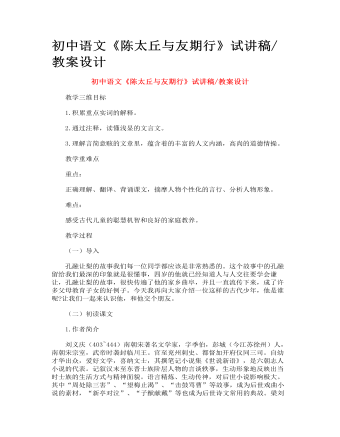
初中语文《陈太丘与友期行》试讲稿_教案设计
刘义庆(403~444)南朝宋著名文学家,字季伯,彭城(今江苏徐州)人,南朝宋宗室,武帝时袭封临川王。官至兖州刺史、都督加开府仪同三司。自幼才华出众,爱好文学,喜纳文士,其撰笔记小说集《世说新语》,是六朝志人小说的代表。记叙汉末至东晋士族阶层人物的言谈轶事,生动形象地反映出当时士族的生活方式与精神面貌。语言精炼、生动传神,对后世小说影响极大。其中“周处除三害”、“望梅止渴”、“击鼓骂曹”等故事,成为后世戏曲小说的素材,“新亭对泣”、“子猷献戴”等也成为后世诗文常用的典故。梁刘孝标作注,旁征博引,为后人所重。另有《幽明录》,今佚。鲁迅《古小说钩沉》辑其佚文200余条,皆记诡异之事。
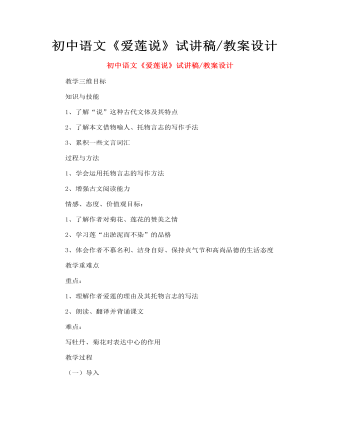
初中语文《爱莲说》试讲稿_教案设计
初读课文 了解文体,熟悉作者 文章的题目是《爱莲说》“爱”表现了作者的感情,“莲”是这篇文章写作的主体,“说” 在这里指什么? 明确:“说”是一种文体,可以说明事物,也可以发表议论或记叙事物 “说”这种文体可以灵活地运用说明、记叙和议论的表达方式,偏重于议论那么题目的意思是什么呢?可以理解为“谈谈爱莲花的道理”或“说说喜爱莲花的道理” 他爱莲花有什么道理呢?大家在学习课文中一定要开动小脑筋 本文作者周敦颐 ,(10171073) ,宋代道洲(现在湖南省道县)人,字茂叔,哲学家因他世居道县濂溪,后居庐山莲花峰前,峰下有溪,也命名为濂溪,学者就称他为“濂溪先生”
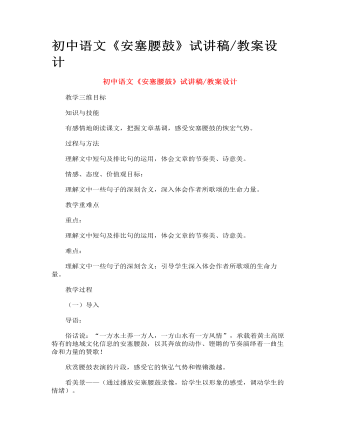
初中语文《安塞腰鼓》试讲稿_教案设计
精读课本,贯通全文 提问:整篇文章极富震撼力,文章中一个排比接一个排比,一个高潮连一个高潮,大家从中体味到了什么? 明确: A、这是一篇歌颂激荡的生命和磅礴的力量的文章。 B、全文洋溢着一种阳刚之美。 C、表现要冲破束缚、阻碍的强烈渴望。 朗读赏析探究 赏美图,配佳句——为了让大家对被誉为“天下第一鼓”的安塞腰鼓有更直观的认识,我们再来看几组特写照片。看后请各小组用课文中的文句与之相配并高声朗读。 明确:对排比句进行总结,说出对句子的理解。 怎样理解“耳畔是一声渺远的鸡声”? ①鸡啼预示天明,是新的一天的开始,是希望的象征。 ②这是以声衬静,用鸡啼反衬火烈的鼓声停止后大地的寂静。 说美点,品美韵——这篇文章美吗?美在哪里? 语言美: 课文多用短句来表现内容;大量运用排比,有句内、句与句、段与段之间的排比,交错出现,连用许多。
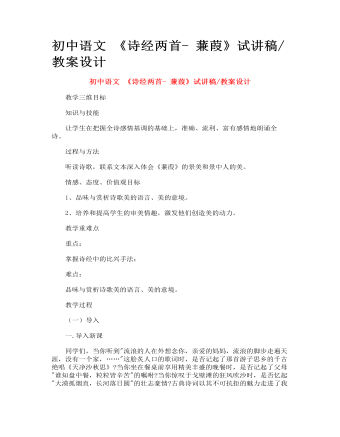
初中语文 《诗经两首- 蒹葭》试讲稿_教案设计
同学们,当你听到"流浪的人在外想念你,亲爱的妈妈,流浪的脚步走遍天涯,没有一个家,……"这脍炙人口的歌词时,是否记起了那首游子思乡的千古绝唱《天净沙秋思》?当你坐在餐桌前享用精美丰盛的晚餐时,是否记起了父母"谁知盘中餐,粒粒皆辛苦"的嘱咐?当你惊叹于戈壁滩的狂风吹沙时,是否忆起"大漠孤烟直,长河落日圆"的壮志豪情?古典诗词以其不可抗拒的魅力走进了我们的生活,为我们的生活增添了更多的美丽与奇妙。今天,让我们一起学习《蒹葭》这首诗歌,再一次用诗歌滋润我们渴求的心灵。
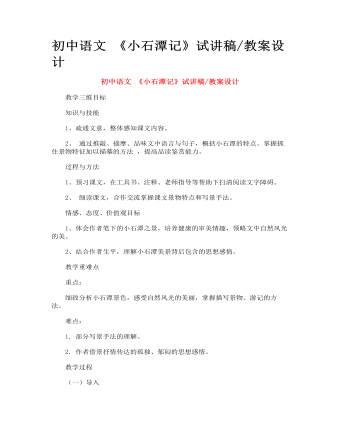
初中语文 《小石潭记》试讲稿_教案设计
大家都知道,在中国文学史上有不少的文人用他们的笔墨描写过优美的山水,比如说我们以前学过: 唐 杜牧《江南春》: 千里莺啼绿映红,水村山郭酒旗风。南朝四百八十寺,多少楼台烟雨中。 杜甫《望岳》:岱宗夫如何? 齐鲁青未了。造化钟神秀,阴阳割昏晓。 荡胸生层云, 决眦入归鸟。 会当凌绝顶, 一览众山小。 郦道元在《三峡》中也有“春冬之时,则素湍绿潭,回清倒影。”这样引人入胜的景色。可以说优美的山水诗文不可枚举,那么今天让我们跟随柳宗元一起走进小石潭,看看又是怎样的一幅山水画呢?他又是怎样的心情写下这篇游记的呢?
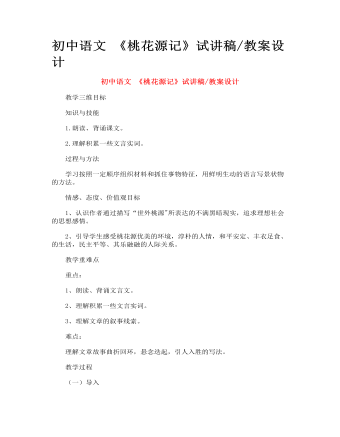
初中语文 《桃花源记》试讲稿_教案设计
陶渊明生于东晋末朝,出身于没落的地主官僚家庭。他少时颇有壮志,博学能文,任性不羁。当时社会动乱不安,他有志不得展。做过小官,由于不满官场的丑恶,弃官回乡,这时他四十一岁,从此过着“躬耕自资”的隐居生活。忧愤、饥寒、劳累、赢疾一起折磨着他,六十三岁去世。后称靖节先生。他所作的诗文,内容多描写农村生活,表现了优美的自然风光,抒发他热爱田园生活、乐于和农民来往和不愿与统治者同流合污的高尚感情;但也包含了乐天知命、消极适世的因素。在形式上一反当时华而不实的文风,明朗清新,质朴自然,善于抓住客观事物最突出的特征,淡淡几笔传神的表现它的形象,简洁含蓄而富有韵味,对后代作家有较大的影响。本文写作年代大约是宋永初二年(421年),其时陶渊明已经五十七岁了。他拒绝同刘格的来政权合作,不满黑暗的政治现实,同时由于他和农民接近,理解他们追求理想社会的愿望,所以写了这篇记和诗。

新人教版高中英语选修2Unit 2 Bridging Cultures-Discovering useful structures教学设计
The grammar of this unit is designed to review noun clauses. Sentences that use nouns in a sentence are called noun clauses. Nominal clauses can act as subject, object, predicate, appositive and other components in compound sentences. According to the above-mentioned different grammatical functions, nominal clauses are divided into subject clause, object clause, predicate clause and appositive clause. In this unit, we will review the three kinds of nominal clauses. Appositive clauses are not required to be mastered in the optional compulsory stage, so they are not involved.1. Guide the students to judge the compound sentences and determine the composition of the clauses in the sentence.2. Instruct students to try to learn grammar by generalizing grammar rules, controlling written practice, and semi-open oral output.3. Inspire the students to systematize the function and usage of noun clause1.Instruct students to try to learn grammar by generalizing grammar rules, controlling written practice, and semi-open oral output.2.Inspire the students to systematize the function and usage of noun clauseStep1: The teacher ask studetns to find out more nominal clauses from the reading passage and udnerline the nominal clauses.
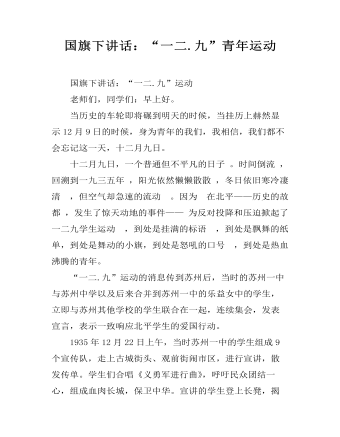
国旗下讲话:“一二.九”青年运动
国旗下讲话:“一二.九”运动老师们,同学们:早上好。当历史的车轮即将碾到明天的时候,当挂历上赫然显示12月9日的时候,身为青年的我们,我相信,我们都不会忘记这一天,十二月九日。十二月九日,一个普通但不平凡的日子 。时间倒流 ,回溯到一九三五年 ,阳光依然懒懒散散 ,冬日依旧寒冷凄清 ,但空气却急速的流动 。因为 在北平——历史的故都 ,发生了惊天动地的事件—— 为反对投降和压迫掀起了一二九学生运动 ,到处是挂满的标语 ,到处是飘舞的纸单,到处是舞动的小旗,到处是怒吼的口号 ,到处是热血沸腾的青年。“一二.九”运动的消息传到苏州后,当时的苏州一中与苏州中学以及后来合并到苏州一中的乐益女中的学生,立即与苏州其他学校的学生联合在一起,连续集会,发表宣言,表示一致响应北平学生的爱国行动。1935年12月22日上午,当时苏州一中的学生组成9个宣传队,走上古城街头、观前街闹市区,进行宣讲,散发传单。学生们合唱《义勇军进行曲》,呼吁民众团结一心,组成血肉长城,保卫中华。宣讲的学生登上长凳,揭发蒋介石政府在北平镇压学生,与日本帝国主义达成妥协的罪行。学生们讲得声泪俱下,而有自行车的学生则担任联络员,传递消息。
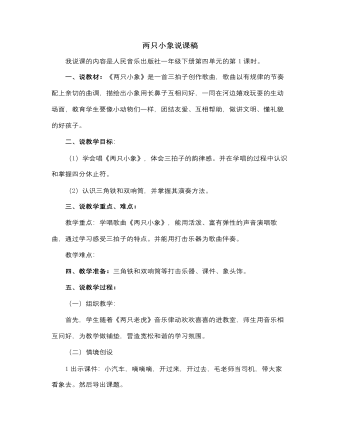
人音版小学音乐一年级下两只小象说课稿
又能再次让学生体会三拍子的韵律感。在配打击乐器为歌曲伴奏这个环节我通过“看图片、找乐器、读节奏、选节奏、敲乐器”等活动充分调动学生学习的积极性,再次掀起学生们的学习乐趣。五、总结:今天我们在动物园和小动物们度过了愉快的一天,我们应爱护小动物,和它们做朋友,而且更要像小动物们一样,团结友爱、互相帮助,做懂礼貌的好孩子。并预告下节课将做象头饰及分小组比赛表演。(在《两只小象》音乐中律动出教室。)总体来说,本方案的设计利用多媒体为学生创设一种生动、直观的教学情景,通过看、听、唱、舞等手段,充分调动了学生的兴趣和积极性,同时在各种音乐活动中,充分体现了学生自主、合作、探究的学习方式,使学生会学、乐学、敢学,将学生自主学习与创新意识的培养落到了实处.
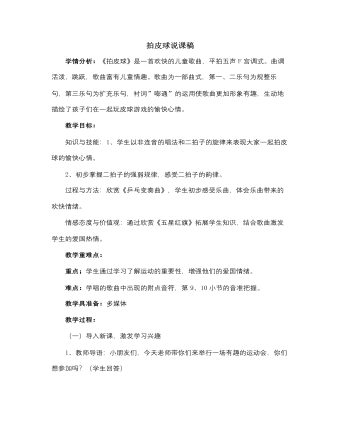
人音版小学音乐一年级下拍皮球说课稿
多媒体反复播放童声齐唱歌曲《五星红旗》,出示歌谱歌词,画面滚动播放各种五星红旗升起的情景以及运动健儿为国争光的一瞬间。(鼓励学生站起来,可以加上拍手的一些动作跟着音乐边唱边体会歌曲情绪,把课堂推向高潮。)师:小朋友们,当国歌再次奏起,看到冉冉升起的五星红旗,我们的心情是多么的激动,我们一起来呼喊”五星红旗,我们的国旗,我们热爱您”(学生跟着老师一起呼喊)。让我们用自己的歌声来表达我们此时的心情吧。设计意图:通过《五星红旗》的欣赏,升华对祖国的热爱之情。(四)总结下课奥运健儿们的那种顽强的奥运精神,坚强的毅力,都是值得我们小朋友一起学习的,我们就从最简单的拍皮球,跳绳开始吧,好好锻炼身体,将来在各种岗位上为国家争光。
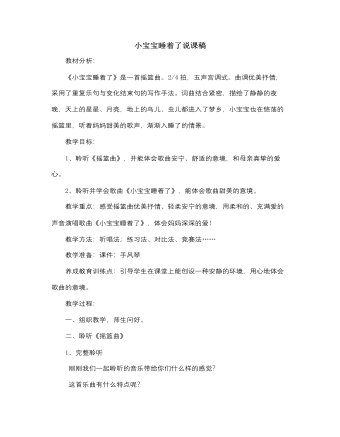
人音版小学音乐一年级下小宝宝睡着了说课稿
三、聆听、表演《小宝宝睡着了》 1、聆听歌曲启发学生说说听到歌曲时感受到了什么?2、复听,跟着歌曲,轻柔地拍节拍。 3、听琴声逐句学唱歌曲。 4、指导学生用连贯、轻柔的声音,唱准、唱好歌曲。 5、重点引导学生说说结尾的处理方式——对比练习,看哪一种方法更恰当 6、引导学生用自己创作的方式为歌曲伴奏、伴舞。 四、小结。 教学反思:一年级课堂上会有一些学生在上课的时候出现喊唱的现象,我在歌曲处理这一环节对歌曲的意境作了这样的描述:静静的夜晚,天上的星星睡了、月亮睡了、地上的鸟儿、虫儿也都进入了梦乡,小宝宝也在悠荡的摇篮里,听着妈妈甜美的歌声,渐渐入睡了。同学们妈妈哄宝宝睡觉唱歌的声音应该是欢快的,还是轻柔的?经过我的描绘和讲解学生理解了在演唱摇篮曲时应该用轻柔的声音,要把每一句都连贯的唱起来,不仅句与句之间要连贯,第一、第二段也要衔接紧凑,轻轻的哼唱出来,体会妈妈哄小宝宝睡觉时是多么的温柔。
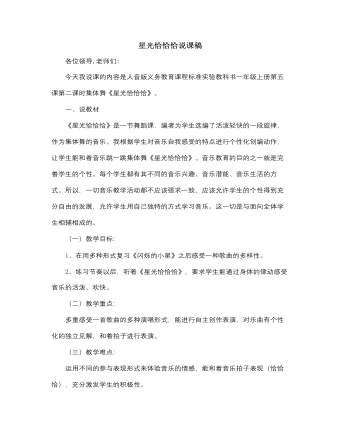
人音版小学音乐一年级下星光恰恰恰说课稿
为了进一步激发学生表演,我特意加上了舞蹈比赛这一环节, 每两小组分别表演,其他四个小组投票选择,选出优胜组,最后胜出的三个小组,再向大家展示。让学生多练多跳,激发起学生的参与意识.四、发展阶段让学生思考能变换什么队形,两人结伴或者几个人,学生自己编创组合队形。在本节课中,这个环节比较符合教学内容,通过自己的创作体验,学生就有了创新,有了突破,这就是创造性的体现,也是发展个性的体现.五、总结阶段本课我采用了归纳式的结尾,来归纳本课的教学内容,提出优点,缺点及改正方向.本课的课件为图文结合法,目的是激发情趣.,重点突出,一目了然,充分展现乐曲意境,让学生有身临其境之感.总之本课的设计考虑到了音乐学科的特点,课时的教学任务,学生的年龄特点等因素,运用各种教学媒体辅助教学,尤其是电脑媒体的介入,应该能使得课堂气氛活跃,让学生的学习兴趣,始终处于积极状态,充分体现了音乐、美术加以综合的审美育人功能.
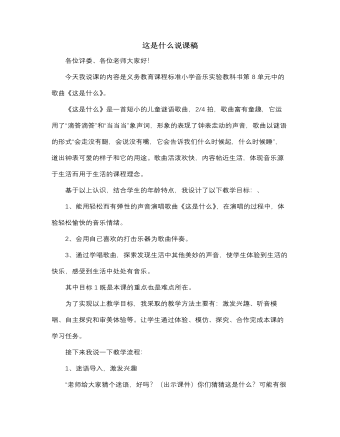
人音版小学音乐一年级下这是什么说课稿
新课标指出,在教学中应注意培养学生自信的演唱,演奏能力及综合性艺术表演能力。我通过举办小小音乐会,把学生分成乐器组和表演组,乐器组的同学使用打击乐为歌曲伴奏,表演组的同学即兴创编动作,让学生在歌表演伴奏教学活动中鼓励学生大胆模仿、想象,培养学生即兴表演能力和人与人这间的合作精神,并让学生在活动中享受美的愉悦,受到情感陶冶,从而把课堂推向高潮。4、深化主题,拓展视野为了拓展学生的音乐视野,深化课堂,我鼓励学生探索和发现生活中其它美妙的声音,(出示课件)“闹钟是我们身边的好朋友,你身边还有哪些能发出响声的好朋友呢?你能不能把他们也变成音乐唱出来呢?”这样让学生感受到生活中处处有音乐,并且挖掘了教材的真正意图,体现音乐课的真正价值。孩子们在歌声中结束了本课的学习,意犹未尽。
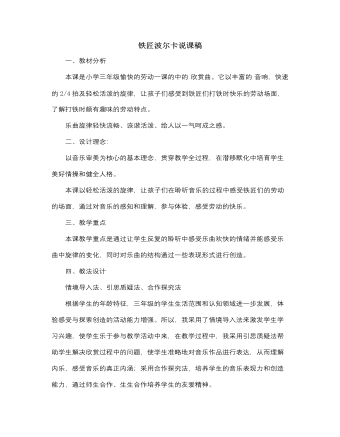
人音版小学音乐一年级下铁匠波尔卡说课稿
接受能力强的学生分为一组,让他们互相监督自己练习;接受能力弱的学生分为一组,老师进行个别教育。 通过分组教学得到因材施教的作用。(用传统的跟学法让学生直观地学会边歌曲边表演动作。通过分组教学得到因材施教和学生自主学习的效果。)(四)师生一起边唱边跳互动表演。(通过尽情的表演让学生张扬个性,满足孩子的表演欲望。)(五)课后作业:课后练习边唱《粉刷匠》边跳舞。(让学生学习的内容得到巩固。)(六)课堂延伸和总结 小粉刷匠热爱劳动,不怕脏不拍累,小朋友们向他学习,在学校要主动打扫卫生,在家要积极做自己力所能及的家务活,做一个爱劳动的好孩子。 (延伸课堂内容,提高教学效果。)总之,在这些活动中,更重要的是我们的学生能通过自身的感受、体验而获得情感审美上的升华,提高他们的动作协调性,为热爱音乐、热爱艺术、热爱生活打下良好基础。
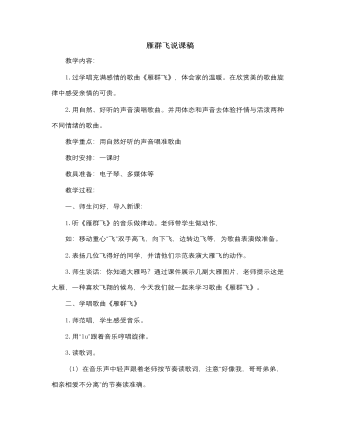
人音版小学音乐一年级下雁群飞说课稿
(1)在音乐声中轻声跟着老师按节奏读歌词,注意“好像我,哥哥弟弟,相亲相爱不分离”的节奏读准确。(2)老师读上半句,学生读下半句。4.逐句教唱,解决难点乐句“飞来飞去不分离”。5.找出旋律相同的两句,用不同的图形或字母表示出来,如:ABA。6.《雁群飞》是一首优美抒情的歌曲,应该用什么样的声音和感情演唱歌曲呢?学生说一说,有感情的演唱歌曲。7.分小组进行简单的动作创编,注意表现出歌曲中的相同与不同。8.学生表演。9.教师与学生一起评一评。三、教师小结。教后记:为了能让学生理解到歌曲的结构,我设问,“歌曲中哪些地方是重复的?”学生经过老师的引导,用笔勾画出了歌曲中重复的乐句。这时我形象地比喻道,它的结构有点像我哦们吃的“肉夹馍”,两边是馍中间有一块好吃的肉,学生一下哈哈大笑起来,还不时地回味说,“真像‘肉夹馍’。”听到这样的回答,我想学生一定对歌曲的结构有了清晰的认识。

